Union Bay Wild: An Artist's View
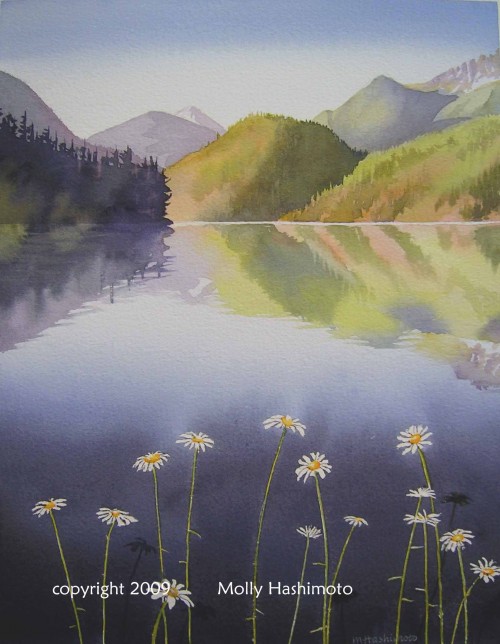
By Molly Hashimoto
Teaching landscape watercolor in summer and autumn at the North Cascades Environmental Learning Center on Diablo Lake encompasses everything I love best: peaks, forests, water, wildlife and enthusiastic fellow artists. When I am at home in Seattle, I seek out the quieter parks nearby, especially Union Bay Natural Area, also known as the Montlake Fill, which seems to have a little of all those things I treasure in the North Cascades.
It is surprising that a place so rich with wildlife is less than a mile from the University Village shopping center, right off Sandpoint Way east of the University of Washington, and adjacent to its enormous parking lots. You can be entirely unaware of all that bustle, although in winter you can see the buildings to the north through a grove of leafless cottonwoods. The Natural Area is on land owned by the University of Washington.
In 1895, Lake Washington was lowered and the University was moved from downtown to its present site, which included the marshy land exposed by the lowering of the lake. At that time no one could think of a way to use this area, so in 1926, when the City of Seattle asked the University if they could pay to use it as a dump and a landfill, the university agreed. In 1971, the Fill finally closed. In 1977, the University’s regents approved a plan that would create an arboretum and keep a natural area for the study of horticulture, as well as a wild area.
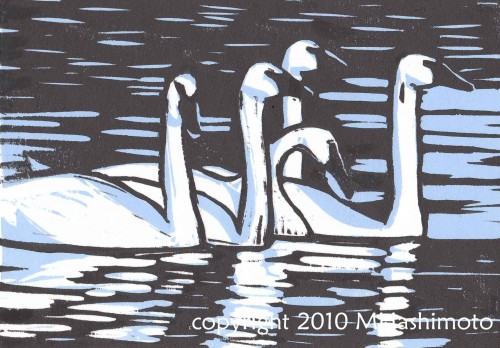 Top: First Light, North Cascades, watercolor on paper. Above: Swans, Union Bay, woodblock print. One of the most beautiful sights I’ve seen at the Natural Area were the trumpeter swans in Yesler Cove in late winter of 2009. They are rare visitors, and that year they graced us with their presence for several days—seeing them inspired the design for this woodblock print.
Top: First Light, North Cascades, watercolor on paper. Above: Swans, Union Bay, woodblock print. One of the most beautiful sights I’ve seen at the Natural Area were the trumpeter swans in Yesler Cove in late winter of 2009. They are rare visitors, and that year they graced us with their presence for several days—seeing them inspired the design for this woodblock print.
You can read more about the history in Constance Sidles’ wonderful book, In My Nature: A Birder’s Year at the Montlake Fill. You can also keep up with bird sightings there on Connie’s website. I’m much indebted to Connie for the information she has shared with me over the time I have been visiting the Natural Area. In her book she quotes Gary Snyder:
“Wilderness is simply a place that has been left wild for a while. It doesn’t have to be pristine. It doesn’t have to be virgin. Everything will become wilderness again, sooner or later. Nature’s resilience and inevitability mean that the universe is ultimately wild…â€
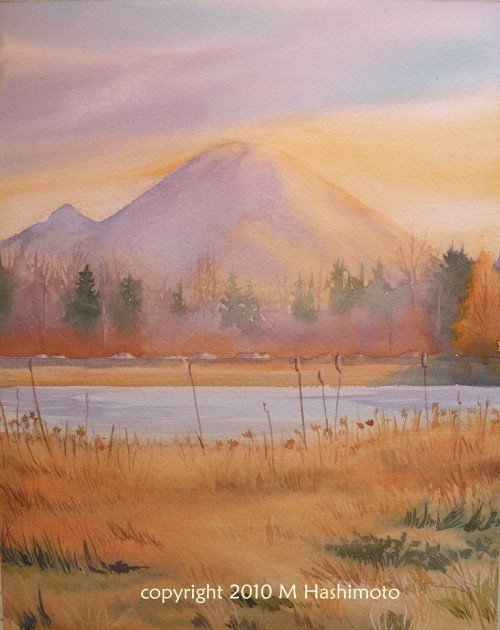 Mt. Rainier from Union Bay, winter, watercolor on paper. One of my favorite times to walk at Union Bay in winter is early morning or late afternoon—when the golden light bathes the dry grasses and cattails.This is my painting of one of those afternoons, looking south across the bay towards Highway 520 and Mt. Rainier.
Mt. Rainier from Union Bay, winter, watercolor on paper. One of my favorite times to walk at Union Bay in winter is early morning or late afternoon—when the golden light bathes the dry grasses and cattails.This is my painting of one of those afternoons, looking south across the bay towards Highway 520 and Mt. Rainier.
The Montlake Fill has been one of Seattle’s best birding locations for decades. More than 240 species of birds have been sighted there. I’ve used my camera to photograph many species—the zoom helps me get close to birds, and even assists me in identification, as I can’t always see them well enough through my camera viewfinder if I don’t have my binoculars with me. I put the photos up on my computer screen when I get home, and with the help of my bird identification guidebooks, I can figure out what I was looking at.
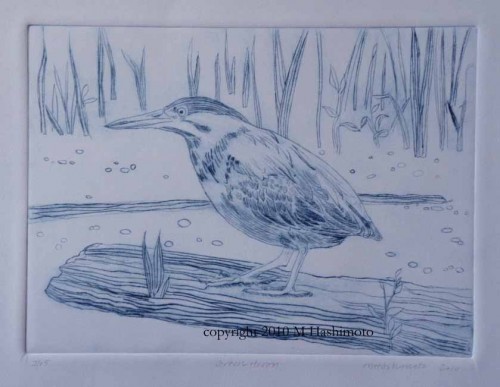
Green Heron, intaglio print. I had no trouble identifying this green heron, but I did find my photographs very useful when it came to creating the art. After seeing my intaglio print, a friend shared a quote from Mary Oliver’s prose work At Blackwater Pond: “The green heron…looks like nothing so much as a polished jar waiting for flowers.â€
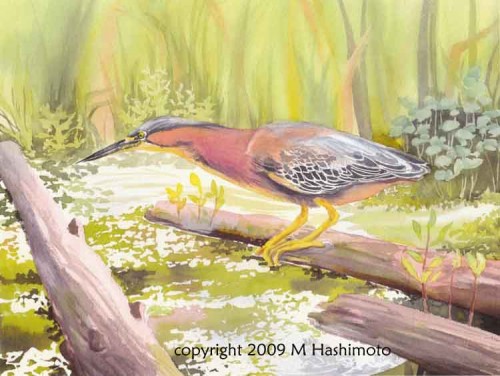 Green Heron at Union Bay, watercolor on paper. This is a watercolor of the same heron, stretching its neck to look for fish. I meet so many interesting people at Union Bay; just this week I met a birder who told me that green herons are tool-users. They have been observed dropping insects into the water to attract fish—an avian fly-fisher!
Green Heron at Union Bay, watercolor on paper. This is a watercolor of the same heron, stretching its neck to look for fish. I meet so many interesting people at Union Bay; just this week I met a birder who told me that green herons are tool-users. They have been observed dropping insects into the water to attract fish—an avian fly-fisher!
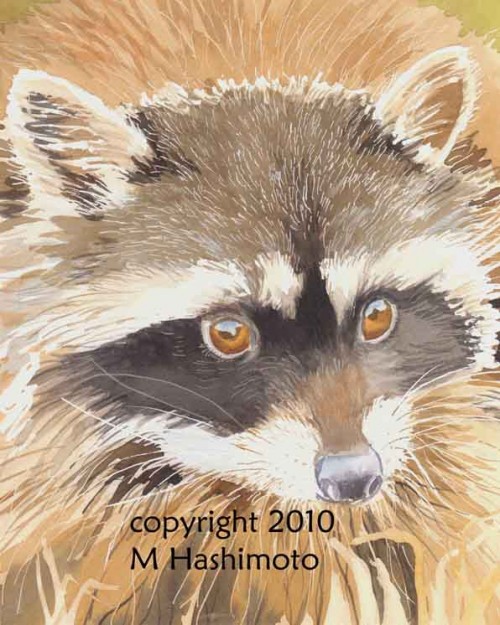 Raccoon, Union Bay, watercolor on paper. Many of the creatures of Union Bay are very common, like raccoons, who prowl in many locations and raid grebe nests. My friend and I encountered this bold raccoon at the Husky Boat Launch. Other common residents are red-winged blackbirds, mallards, coyotes, tree swallows, and dragonflies. I’ve also observed some very uncommon urban sights—like a meadowlark, a snipe, an osprey, a Northern shrike, and a bittern.
Raccoon, Union Bay, watercolor on paper. Many of the creatures of Union Bay are very common, like raccoons, who prowl in many locations and raid grebe nests. My friend and I encountered this bold raccoon at the Husky Boat Launch. Other common residents are red-winged blackbirds, mallards, coyotes, tree swallows, and dragonflies. I’ve also observed some very uncommon urban sights—like a meadowlark, a snipe, an osprey, a Northern shrike, and a bittern.
The paths and proximity to the University guarantee heavy human use of Union Bay Natural Area—people on bikes and on foot commute to the University through the Area, and I frequently share the trail with the Husky track team. Once on the southwest edge, I ran into the UCLA football team on a bus. I often wish the Natural Area was a little quieter, but the presence of wetlands in Seattle, after earlier development eliminated so many of these critically important habitats, ensures that many birds will need and use this space—noise or not. For me, that makes the beauty here all the more poignant. Making Union Bay Natural Area the subject for my art is a way of recognizing the importance of this place. You can read more about Union Bay Natural Area on my website, Molly Hashimoto Artist’s Journal, where I write about art, nature and ideas.
On February 3rd, I’ll be hosting a free artist reception for my exhibit, Union Bay Wild, from 5 to 7 p.m. at the Elisabeth Miller Library at the University of Washington Botanic Gardens and the Center for Urban Horticulture, adjacent to the Union Bay Natural Area. The exhibit runs through March 24th and the subject is wildlife and landscapes of the Natural Area. Media will include watercolors, woodblock and intanglio prints and acrylic paintings.


I really enjoyed your article as I never knew the history of the Montlake Fill. In high school I remember going there to birdwatch with the Seattle Audubon Society, and also being struck by its wildness in the middle of the city. The watercolors are so beautiful! I live in Korea right now but when I’m back in the Pacific Northwest I would love to come to an artist reception or take a class through the NCI.
Thanks Molly for this blog-I always learn something new when I read these. Love your work and am glad I finally got you to Coupeville-folks loved your watercolor class. Hope we can do it again in the future. Love NCI and all it has to offer.